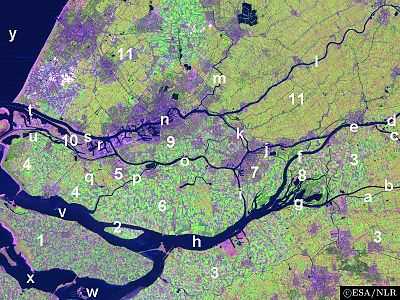Hoeksche Waard
The Hoekse Waard (Dutch pronunciation: [ˈɦuksə ˈʋaːrt]; pre-1947 spelling: Hoeksche Waard) is an island between the Oude Maas, Dordtsche Kil, Hollands Diep, Haringvliet and Spui rivers in the province of Zuid Holland in the Netherlands. The island is a mostly agricultural region, south of Rotterdam. The Hoeksche Waard consists of reclaimed land (polders): after the Saint Elisabeth flood of 1421 most of the area was flooded. The land has been reclaimed gradually in the following centuries.[1]
Municipalities
The Hoeksche Waard consists of the following municipalities:
- Binnenmaas (villages Blaaksedijk, Heinenoord, Goidschalxoord, Maasdam, Mijnsheerenland, Puttershoek, Westmaas and 's-Gravendeel)
- Cromstrijen (villages Klaaswaal and Numansdorp)
- Korendijk (villages Goudswaard, Nieuw-Beijerland, Piershil and Zuid-Beijerland)
- Oud-Beijerland
- Strijen (villages Cillaarshoek, Mookhoek, Strijen and Strijensas)
Surrounding waters
The Hoeksche Waard is separated:
- from IJsselmonde island on the north by the Oude Maas (tunnel)
- from Voorne-Putten island on the west by the Spui (ferry)
- from the island of Dordrecht on the east by the Dordtsche Kil (tunnel)
- from Goeree-Overflakkee island on the southwest by the Haringvliet (bridge)
- from the Province of North Brabant on the southeast by the Hollands Diep (bridge)
References
- ↑ Karel Leenders (1999). "Geschiedenis van de Hoeksche Waard" (in Dutch).
